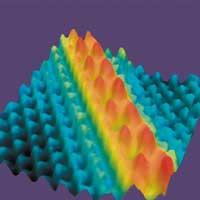Exchange of atoms
A step forward has been taken that can help the manufacture of electronic nanocyroid complexes: a group of physicists have succeeded in replacing a silicon atom on the silicon surface with a phosphorus atom.
This is an important milestone as the addition to silicon of non-conductive metal atoms will help to design complex atomic circuits for the transport of electricity.

The movement of the metal atoms by one with the tunnel effect microscope is not new, but can be removed electrically with the microscope probe. But the movement of semiconductor materials is very different, and these materials are the ones used to make nanochips.
Not being able to directly extract the silicon atom, in this research they have had to use hydrogen to move it. When silicon skin is treated with hydrogen, it immediately binds to all silicon atoms. It then extracts the hydrogen atom selected by the researcher using the microscope probe and binds to the silicon where phosphorus has been free to treat skin with trihydro or phosphine phosphorus.
Heating this up to 350°C, the molecules have disintegrated and silicon and phosphorus have replaced each other, that is, one atom occupies the place of the other.





